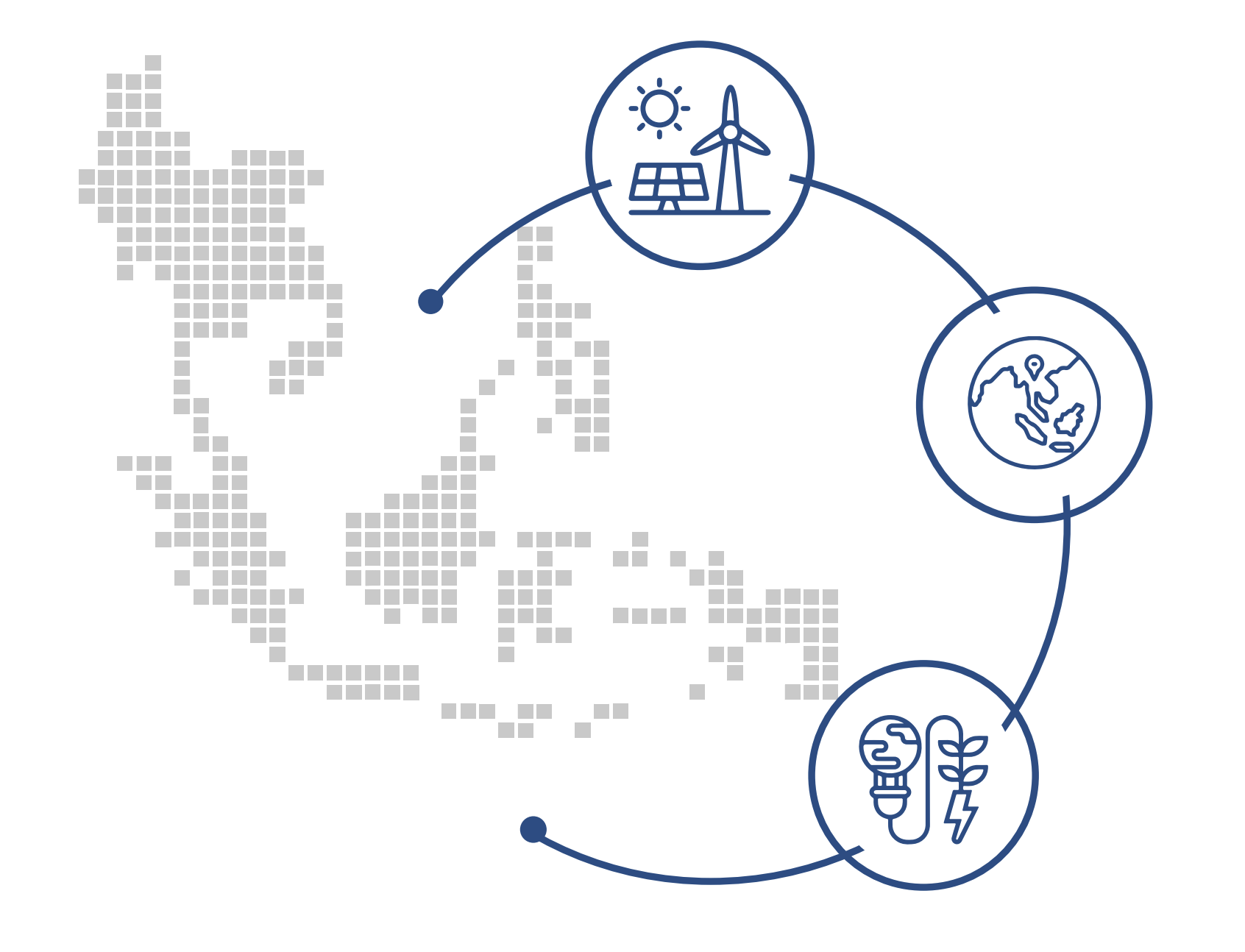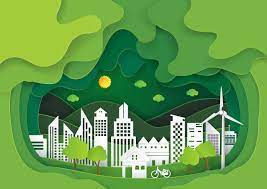Background
Vietnam is located in South East Asia and has a tropical climate in the south and a monsoon climate in the north. Vietnam has low, flat deltas in the south and north, and highlands and mountains in the far north and northwest. Some of its environmental challenges include deforestation and soil degradation from agricultural malpractices, over-exploitation of marine resources and water pollution. The development of the industry sector has been key for Vietnam’s economic growth, accounting for a share of more than 42% of GDP in 2013. However, the service sector has now become the predominant one, accounting for a share of 41% of GDP in 2017, whilst the Industry sector decreased to 32% and agriculture 15.9% [1]. The country has been industrializing at an increasing pace, with knock-on effects on Vietnam’s energy consumption levels, especially of coal and oil, leading to growing carbon dioxide emissions levels. In 2012, Vietnam emitted 251 million metric tons of carbon dioxide equivalent (MtCO2e). The energy sector was responsible for 66 % of emissions, the agriculture sector for 23% and industrial sector for 12% [2]. The World Bank estimates that in 2014, CO2 emissions (metric tons per capita) reached 1.82; the data shows an upward trend [3].
In 2000, renewable energy, including biomass and hydro together, contributed 53% of the total primary energy supply; by 2015, this share dropped to 24% and coal share grew from 15% to 35% of total supply [4]. Power plants are major consumer of domestic coal, then cement, fertilizer and chemical sectors.
Overall Fiscal Profile
Vietnam’s overall GDP growth peaked in 1995 at 9.5% and since then has experienced oscillations, with Foreign Direct Investment (FDI) and the export market being key determinants of growth and its variability. In 2018, GDP growth was at 7 percent [5]. The fiscal deficit increased in 2013, with further increases in 2014, owing to higher public debt and decreased tax revenue (as a share of GDP). It decreased in 2016, and has been increasing since [6]. In 2012, the account surplus spiked to US$9.1 billion from US$0.2 billion in the previous year due to the export market, and dwindling imports. Between 2016 and 2017, exports and imports rose by 20 percent [7]. While in the short term, risks exist including volatility, higher global interest rates, and geopolitical tensions, the IMF suggests a focus on broadening the revenue base and targeted social spending. As a result, Vietnam has the potential to expand its fiscal base by adopting further green fiscal policy measures.
Vietnam has implemented a range of policies and strategies, such as the National Power Development plan with the vision to 2030, and the Renewable Energy Development Strategy, which include plans for the exploitation of domestic fossil fuel resources and for the increase use of renewable energy. In terms of securing investment in the energy sector, the government has been instrumental in attracting investment capital from private and foreign investors, particularly through mobilization of state finance from state-owned enterprises and development policies for energy sector [8].
Policy and Legal Framework for a Green Economy
Vietnam’s Green Growth Strategy, which was adopted in September 2012, is based on three core strategic axes: low-carbon growth; greening of production and greening of lifestyles. Priority areas include efficient resource use, reduction of environmental degradation, reduction of GHG, restoration of natural capital and creation of green jobs; with milestones to 2050.
Targets under the Green Growth Strategy include:
- Reducing GHG emission intensity by 8-10% from a 2010 baseline throughout the period 2011-2020
- Reducing energy consumption by 1-1.5% per year per unit of GDP. Increasing the value of high-technology and green technology to a share of 42-45 per cent of GDP by 2020
- Enriching natural capital to 3-4 per cent of GDP.
- Mainstreaming green economic development by 2050
The strategy also aspires to promote fast development of green economic sectors to create jobs. In the current implementation period (2011-2020), the strategy is focusing on communication and capacity development, development of tools and indicators, as well as the development of policy mechanisms to support implementation. The government estimates that it needs about US$30 billion by 2020 to implement the Green Growth Strategy. At present, it spends about US$1 billion annually on climate change programmes and activities and aims to establish a Climate Finance Task Force to mobilize additional funding.
With this Strategy, Vietnam seeks to improve access to climate finance and work with sectors and provinces to set targets and identify policy actions and investments, developing synergies between existing work at sectoral level (agricultural and rural development, renewable energy, green industry strategy etc.). In addition, the country has been working on blending Climate and Green Finance sources in private sector investments in infrastructure and power generation. The aim is to incentivize engagement of private sector, both as investor and recipient. While providing government assistance to develop new modalities to facilitate innovation, particularly by subsidizing R&D that engage both public and private sector partners.
Vietnam has also been developing market-based mechanisms to generate finance for green growth. With several measures to lay the groundwork for implementing ‘National Appropriate Mitigation Actions’ (NAMAs) in the waste, steel, cement, chemical fertilizer, wind power, and biogas sectors [9].
Vietnam is also considering the use of market-based instruments for the waste sector starting in 2020. A decree on a road-map for GHG emissions will be approved in 2019, which references the use of carbon credits and a carbon pricing policy system.
In the Strategy, Vietnam announced that it would develop a cap and trade system; however, in 2019 the ETS is still under consideration [10].
Fiscal Measures for a Green Economy
Vietnam passed an environmental tax law in 2010, which came into force in 2012 and introduced an Environment Protection Tax. This made Vietnam a pioneer in environmental tax reform in South East Asia. Taxes are levied on refined fuels and coal as well as on environmentally harmful substances (HCFCs, certain pesticides, soft plastic bags) in the form of consumer unit taxes. The central government determines the tax level for each taxation period. For petrol, the tax rate varies between VND 1,000 to VND 4,000 (US$0.04 to US$0.19) per litre. This corresponds to an ad valorem tax rate of between 5.9 per cent and 17.6 per cent. The environment protection tax (EPT) was expected to generate VND12 trillion ($572 million) in 2012, derived from the tax on oil and petrol. This figure was 14 per cent higher than environment fees collected in 2010. Moreover, an academic assessment of the impact of the EPT estimated that it could increase the Government’s revenues by about 3.5 %. Taxes on coal and refined fuels are expected to account for 99.5% of the estimated tax revenue. The EPT has the potential to reduce Vietnam’s annual CO2 emissions by up to 75% and can contribute up to 1.5 billion euros in additional tax revenue by 2012, which can strengthen fiscal decentralization by allocating funds to both state and provincial budgets. However, GIZ reports some challenges: tax on coal was only equal to 75% of its world market price, and there are concerns lower income households will bear the burden of the tax.
On July 1, 2018, Vietnam’s Ministry of Finance increased the environmental protection taxes on oil and petroleum products to the ceiling level of 4,000 VND (17 US cents) from the previous 3,000 VND (13 US cents) [11], to increase tax collection by over 15,700 billion Vietnamese dong (682.6 million U.S. dollars) a year [12]. The governments hopes the increase in environmental taxes will have an effect on the transport industry and ultimately the selling price of a number of products. And that the hike will help increase the use of environmentally friendly products, such as E5 bio-fuel. If the tax revenues are allocated properly, the transition towards environmentally friendly products will accelerate, thus helping Vietnam reduce emissions and align itself further with international norms on environmental protection.
In addition to the Environment Protection Tax, the government introduced an Environment Protection Fee aimed at wastewater, solid waste and extractive industries. The EPF was introduced in 2003 for wastewater, but to date collection has been challenging, particularly for industrial wastewater discharge. An EPF was introduced in 2007 for solid waste, but the revenues collected from these fees have not been sufficient to offset the cost of collection and treatment of solid waste. Lastly, an EPF was introduced in 2008 on extractive industries, including coal gas, natural gas, crude oil and metallic and non-metallic minerals, and the specific charge depends on the type of natural resource mined. However, collection has been hampered by low compliance on the part of extractive companies.
In May 1, 2016, a decree came into effect to regulate environmental protection charges for mineral exploitation, which applied to crude oil, natural gas, coal gas, metallic and non-metallic minerals, for organizations and individuals doing mining operations and for involved state agencies, other organizations and individuals [13]. In each locality, based on the charge rates enclosed to this Decree, the provincial/cities People’s Councils decide the rate of charges for environmental protection suitable with the actual situation in each period. To ensure transparency, the environmental protection fees contributed by enterprises annually are made public.
The Ministry of Planning and Investment is considering developing a road-map to identify other useful fiscal incentives, such as additional carbon taxes or levies and shifting public investment towards energy efficiency and renewable energies. These efforts could contribute to implementing the Green Growth Strategy and its environmental and economic targets.
Fossil Fuel Subsidy Reform
There are several barriers to the development of renewable energy in Vietnam identified, particular on immature and expensive low carbon technologies, the inadequate financial incentives, and the low grid capacity [14].
There are several types of energy subsidies in Vietnam requiring reform: direct to domestic consumers, low interest or preferential loans and deferred tax liabilities for state owned energy enterprises, and finally reduced taxation on import tariffs for petrol products. As of 2011, energy subsidies amounted to $4.12 billion, accounting for 3.4% of GDP and 8.6% of the state budget in 2010. The largest component of these subsidies is allocated to electricity (70%) but subsidies to coal and gasoline have been decreasing as prices for these fuels have moved towards market levels. Moreover, the government provides low-interest loans and subsidizes the capital investments of EVN, the national electricity utility.
Since 2012, prices have been set more on market-based principles, under the National Energy Development Strategy of 2012, although final decisions about price changes are in the hands of the government under the 2012 Price Law. Coal has not been subject to price stabilization since 2004, but a coal price subsidy has been applied to power generation. Since 2009, the government has allowed coal prices to increase towards market level and a cost-recovery price is currently in force. Electricity subsidy reform is currently in progress, and aims to adjust prices through a market mechanism to reach cost-recovery levels.
Retail electricity tariffs were raised by an average of 25% between 2007 and 2010, and by 17% in 2011. As a mitigation measure, the government provided small cash transfers to low-income households to compensate them for the higher charges. Moreover, lifeline tariffs were introduced in 2009, providing a preferential rate for the first 500KWh of electricity consumed by low-income households. In addition, the government provides subsidies for installing solar water heaters amounting to US$47 per household, through EVN.
In early 2016 the Government of Vietnam approved the adjustments of 7th Vietnam Power Development Planning (PDP7-A) in the period 2011 – 2020 with an outlook up to 2030. Low carbon technologies will play a key role. In addition, the total electricity generation required in Vietnam would reduce about 20% and 18% by 2020 and 2030, respectively. The new Plan seeks to develop power sources from solar energy, raising the total capacity of the solar power projects from the current negligible level to about 850 MW by 2020, 4 GW by 2025, and 12 GW by 2030. This is particularly important for Vietnam, as fossil fuel-based technologies still dominate the power industry and in the past two decades, large investments are still being made in new thermal coal power plants.
The Vietnam National Energy Development Strategy to 2020 with an outlook to 2050 shows the government’s desire to increase energy efficiency, to develop sustainable and clean energy along with environment protection [15]. The government states it seeks to develop a complete energy market, to diversify the ownership in the energy field and the intention to gradually reduce energy subsidies. In 2015, Vietnam underwent a pricing reform illustrated by the increase in domestic prices for gasoline, natural gas and electricity, which suggest policy developments to reduce energy consumption subsidies [16].
References:
[1] Data for GDP composition by sector, for Vietnam in 2017, available at:
https://www.indexmundi.com/vietnam/gdp_composition_by_sector.html
[2] Greenhouse Gas Emissions Factsheet; Vietnam, 2016, available at:
https://www.climatelinks.org/resources/greenhouse-gas-emissions-factsheet-vietnam
[3] World Bank Group, Open Data, Carbon Emissions per country available through the link :
https://data.worldbank.org/indicator/EN.ATM.CO2E.PC?locations=VN
[4] Vietnam Energy Outlook Report 2017
https://ens.dk/sites/ens.dk/files/Globalcooperation/Official_docs/Vietnam/vietnam-energy-outlook-report-2017-eng.pdf
[5] World Bank Group, Open Data, GDP growth (annual %) for Vietnam, available at:
https://data.worldbank.org/indicator/NY.GDP.MKTP.KD.ZG?locations=VN
[6] Data for Vietnam Government Budget deficit, available till 2018, from the Trading Economics website, through the link:
https://tradingeconomics.com/vietnam/government-budget
[7] Data for export and imports for Vietnam from the CIA World Factbook, available at
https://www.cia.gov/library/publications/the-world-factbook/geos/vm.html
[8] Danish Energy Agency, “Vietnam Energy Outlok Report 2017”, (2017), available through the link :
https://ens.dk/sites/ens.dk/files/Globalcooperation/Official_docs/Vietnam/vietnam-energy-outlook-report-2017-eng.pdf
[9] ETS detailed Information for Vietnam, from the International Carbon Action Partnership, last updated April 2019, available at:
https://icapcarbonaction.com/en/?option=com_etsmap&task=export&format=pdf&layout=list&systems%5B%5D=83
[10] ETS detailed Information for Vietnam, from the International Carbon Action Partnership, last updated April 2019, available at:
https://icapcarbonaction.com/en/?option=com_etsmap&task=export&format=pdf&layout=list&systems%5B%5D=83
[11] Dezan Shira and Associates (2018) “Vietnam Proposes Higher Environmental Protection Taxes”, from Vietnam Briefing, available at:
https://www.vietnam-briefing.com/news/vietnam-proposes-higher-environmental-protection-taxes.html/
[12] Xinhua ne, (2018) “Vietnman to increase environmental fees on oil, petrol”, available at: http://www.xinhuanet.com/english/2018-09/21/c_137484180.htm
[13] Integrated Portal of the Vietnam Environment Administration (2016) “New decree on environmental protection charges for mineral exploitation”, available at: http://vea.gov.vn/en/laws/LegalDocument/Pages/New-decree-on-environmental-protection-charges-for-mineral-exploitation.aspx
[14] US Mission to ASEAN (2016), “Renewable Energy in Vietnam: Current plans and Policy Recommendations” available at:
https://asean.usmission.gov/innovasean_20161205/
[15] Vietnam National Energy Development Strategy 2020 (with an outlook to 2050) (2013), Available at:
http://www.asialeds.org/resource/viet-nam-national-energy-development-strategy-2020-with-an-outlook-to-2050/
[16] OECD and the International Energy Agency (2019) “Update on recent progress in reform of inefficient fossil-fuel subsidies that encourage wasteful consumption”, available at:
https://www.oecd.org/fossil-fuels/publication/OECD-IEA-G20-Fossil-Fuel-Subsidies-Reform-Update-2019.pdf
Additional Reading
GIZ, 2011.
Environmental Taxation in Viet Nam. Retrieved from:
http://www.greenfiscalpolicy.org/uncategorized/environmental-taxation-in-vietnam-axel-and-sina-2011/
GSI and IISD, 2012.
A Forum for South East Asian Policy-makers Fossil-Fuel Subsidy Reform: Challenges and Opportunities. Retrieved from:
http://www.iisd.org/gsi/sites/default/files/ffs_gsibali_meetingreport.pdf
Ministry of Planning and Investment, 2012.
Viet Nam Green Growth Strategy and its implication for fossil fuel subsidy reform.
http://www.iisd.org/gsi/sites/default/files/ffs_gsibali_sess1_phuong_0.pdf
Vietnam National Green Growth Strategy. Retrieved from:
https://www.giz.de/de/downloads/VietNam-GreenGrowth-Strategy.pdf
Vietnam Environment Administration,
Environmental Management through Economic Instruments, http://vea.gov.vn/en/EnvirStatus/StateOfEnvironmentNews/Pages/Environmental-management-through-economic-instruments-.aspx






